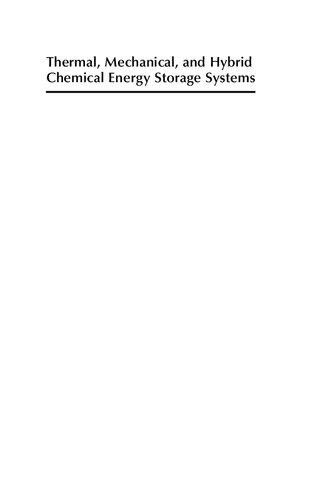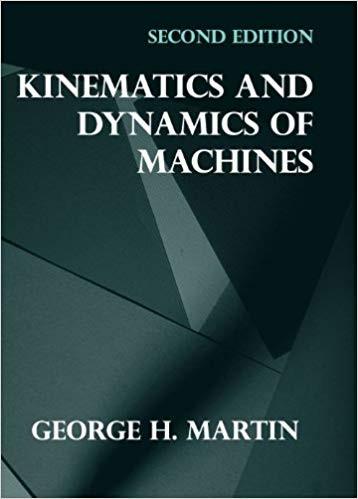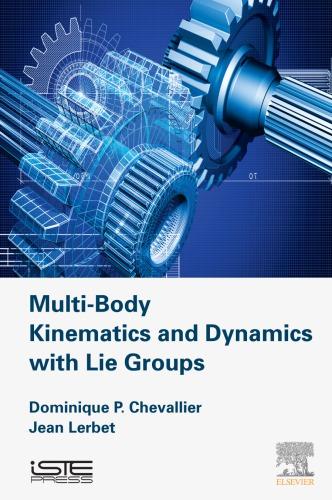Kinematics of general spatial mechanical systems Özgören
Visit to download the full and correct content document: https://ebookmass.com/product/kinematics-of-general-spatial-mechanical-systems-oz goren/

More products digital (pdf, epub, mobi) instant download maybe you interests ...

GATE Mechanical Engineering Topic-wise Practice Tests
Trishna Knowledge Systems
https://ebookmass.com/product/gate-mechanical-engineering-topicwise-practice-tests-trishna-knowledge-systems/

Thermal, mechanical, and hybrid chemical energy storage systems Klaus Brun (Editor)
https://ebookmass.com/product/thermal-mechanical-and-hybridchemical-energy-storage-systems-klaus-brun-editor/

(eTextbook PDF) for Kinematics and Dynamics of Machines
2nd Edition
https://ebookmass.com/product/etextbook-pdf-for-kinematics-anddynamics-of-machines-2nd-edition/

Mechatronics: Electronic Control Systems in Mechanical and Electrical Engineering 7th Edition William Bolton
https://ebookmass.com/product/mechatronics-electronic-controlsystems-in-mechanical-and-electrical-engineering-7th-editionwilliam-bolton/

Multi-body kinematics and dynamics with Lie groups
Chevallier
https://ebookmass.com/product/multi-body-kinematics-and-dynamicswith-lie-groups-chevallier/

Mechanical and Electrical Systems in Architecture, Engineering and Construction 5th Edition – Ebook PDF Version
https://ebookmass.com/product/mechanical-and-electrical-systemsin-architecture-engineering-and-construction-5th-edition-ebookpdf-version/

Electrical and Mechanical Fault Diagnosis in Wind Energy Conversion Systems Monia Ben Khader Bouzid
https://ebookmass.com/product/electrical-and-mechanical-faultdiagnosis-in-wind-energy-conversion-systems-monia-ben-khaderbouzid/

Spatial Analysis John T Kent
https://ebookmass.com/product/spatial-analysis-john-t-kent/

Spatial Analysis John T. Kent
https://ebookmass.com/product/spatial-analysis-john-t-kent-2/

KinematicsofGeneralSpatialMechanicalSystems
KinematicsofGeneralSpatialMechanical Systems
M.KemalOzgoren
MiddleEastTechnicalUniversity
Turkey
Thiseditionfirstpublished2020
©2020JohnWiley&SonsLtd
Allrightsreserved.Nopartofthispublicationmaybereproduced,storedinaretrievalsystem,or transmitted,inanyformorbyanymeans,electronic,mechanical,photocopying,recordingorotherwise, exceptaspermittedbylaw.Adviceonhowtoobtainpermissiontoreusematerialfromthistitleisavailable athttp://www.wiley.com/go/permissions.
TherightofM.KemalOzgorentobeidentifiedastheauthorofthisworkhasbeenassertedinaccordance withlaw.
RegisteredOffices
JohnWiley&Sons,Inc.,111RiverStreet,Hoboken,NJ07030,USA
JohnWiley&SonsLtd,TheAtrium,SouthernGate,Chichester,WestSussex,PO198SQ,UK
EditorialOffice
TheAtrium,SouthernGate,Chichester,WestSussex,PO198SQ,UK
Fordetailsofourglobaleditorialoffices,customerservices,andmoreinformationaboutWileyproducts visitusatwww.wiley.com.
Wileyalsopublishesitsbooksinavarietyofelectronicformatsandbyprint-on-demand.Somecontentthat appearsinstandardprintversionsofthisbookmaynotbeavailableinotherformats.
LimitofLiability/DisclaimerofWarranty
Inviewofongoingresearch,equipmentmodifications,changesingovernmentalregulations,andthe constantflowofinformationrelatingtotheuseofexperimentalreagents,equipment,anddevices,thereader isurgedtoreviewandevaluatetheinformationprovidedinthepackageinsertorinstructionsforeach chemical,pieceofequipment,reagent,ordevicefor,amongotherthings,anychangesintheinstructionsor indicationofusageandforaddedwarningsandprecautions.Whilethepublisherandauthorshaveused theirbesteffortsinpreparingthiswork,theymakenorepresentationsorwarrantieswithrespecttothe accuracyorcompletenessofthecontentsofthisworkandspecificallydisclaimallwarranties,including withoutlimitationanyimpliedwarrantiesofmerchantabilityorfitnessforaparticularpurpose.Nowarranty maybecreatedorextendedbysalesrepresentatives,writtensalesmaterialsorpromotionalstatementsfor thiswork.Thefactthatanorganization,website,orproductisreferredtointhisworkasacitationand/or potentialsourceoffurtherinformationdoesnotmeanthatthepublisherandauthorsendorsethe informationorservicestheorganization,website,orproductmayprovideorrecommendationsitmaymake. Thisworkissoldwiththeunderstandingthatthepublisherisnotengagedinrenderingprofessionalservices. Theadviceandstrategiescontainedhereinmaynotbesuitableforyoursituation.Youshouldconsultwitha specialistwhereappropriate.Further,readersshouldbeawarethatwebsiteslistedinthisworkmayhave changedordisappearedbetweenwhenthisworkwaswrittenandwhenitisread.Neitherthepublishernor authorsshallbeliableforanylossofprofitoranyothercommercialdamages,includingbutnotlimitedto special,incidental,consequential,orotherdamages.
LibraryofCongressCataloging-in-PublicationDataAppliedfor
HardbackISBN:9781119195733
CoverDesign:Wiley
CoverImage:©PhonlamaiPhoto/Shutterstock
Setin10/12ptWarnockProbySPiGlobal,Chennai,India
PrintedandboundbyCPIGroup(UK)Ltd,Croydon,CR04YY 10987654321
Toallthereaderswhomayenjoyandmakeuseofthisbook
Contents
Preface xv
Acknowledgments xix
ListofCommonlyUsedSymbols,Abbreviations,andAcronyms xxi AbouttheCompanionWebsite xxvii
1VectorsandTheirMatrixRepresentationsinSelectedReference Frames 1
1.1GeneralFeaturesofNotation 1
1.2Vectors 2
1.2.1DefinitionandDescriptionofaVector 2
1.2.2EqualityofVectors 2
1.2.3OppositeVectors 3
1.3VectorProducts 3
1.3.1DotProduct 3
1.3.2CrossProduct 3
1.4ReferenceFrames 4
1.5RepresentationofaVectorinaSelectedReferenceFrame 6
1.6MatrixOperationsCorrespondingtoVectorOperations 7
1.6.1DotProduct 7
1.6.2CrossProductandSkewSymmetricCrossProductMatrices 8
1.7MathematicalPropertiesoftheSkewSymmetricMatrices 9
1.8ExamplesInvolvingSkewSymmetricMatrices 10
1.8.1Example1.1 10
1.8.2Example1.2 11
1.8.3Example1.3 11
2RotationofVectorsandRotationMatrices 13
2.1VectorEquationofRotationandtheRodriguesFormula 13
2.2MatrixEquationofRotationandtheRotationMatrix 15
2.3ExponentiallyExpressedRotationMatrix 16
2.4BasicRotationMatrices 16
2.5SuccessiveRotations 17
2.6OrthonormalityoftheRotationMatrices 18
2.7MathematicalPropertiesoftheRotationMatrices 20
2.7.1MathematicalPropertiesofGeneralRotationMatrices 20
2.7.2MathematicalPropertiesoftheBasicRotationMatrices 22
2.8ExamplesInvolvingRotationMatrices 22
2.8.1Example2.1 22
2.8.2Example2.2 23
2.8.3Example2.3 24
2.8.4Example2.4 24
2.9DeterminationoftheAngleandAxisofaSpecifiedRotationMatrix 25
2.9.1ScalarEquationsofRotation 25
2.9.2DeterminationoftheAngleofRotation 26
2.9.3DeterminationoftheAxisofRotation 26
2.9.4DiscussionAbouttheOptionalSignVariables 29
2.10DefinitionandPropertiesoftheDoubleArgumentArctangentFunction 29
3MatrixRepresentationsofVectorsinDifferentReferenceFramesand theComponentTransformationMatrices 31
3.1MatrixRepresentationsofaVectorinDifferentReferenceFrames 31
3.2TransformationMatricesBetweenReferenceFrames 32
3.2.1DefinitionandUsageofaTransformationMatrix 32
3.2.2BasicPropertiesofaTransformationMatrix 33
3.3ExpressionofaTransformationMatrixinTermsofBasisVectors 34
3.3.1Column-by-ColumnExpression 34
3.3.2Row-by-RowExpression 34
3.3.3Remark3.1 35
3.3.4Remark3.2 35
3.3.5Remark3.3 36
3.3.6Example3.1 36
3.4ExpressionofaTransformationMatrixasaDirectionCosineMatrix 37
3.4.1DefinitionsofDirectionAnglesandDirectionCosines 37
3.4.2TransformationMatrixFormedasaDirectionCosineMatrix 38
3.5ExpressionofaTransformationMatrixasaRotationMatrix 38
3.5.1CorrelationBetweentheRotationandTransformationMatrices 38
3.5.2DistinctionBetweentheRotationandTransformationMatrices 39
3.6RelationshipBetweentheMatrixRepresentationsofaRotationOperatorin DifferentReferenceFrames 40
3.7ExpressionofaTransformationMatrixinaCaseofSeveralSuccessive Rotations 40
3.7.1RotatedFrameBased(RFB)Formulation 41
3.7.2InitialFrameBased(IFB)Formulation 41
3.8ExpressionofaTransformationMatrixinTermsofEulerAngles 42
3.8.1GeneralDefinitionofEulerAngles 42
3.8.2IFB(InitialFrameBased)EulerAngleSequences 42
3.8.3RFB(RotatedFrameBased)EulerAngleSequences 43
3.8.4Remark3.4 44
3.8.5Remark3.5 44
3.8.6Remark3.6:PreferenceBetweenIFBandRFBSequences 45
3.8.7CommonlyUsedEulerAngleSequences 45
3.8.8ExtractionofEulerAnglesfromaGivenTransformationMatrix 46
3.9PositionofaPointExpressedinDifferentReferenceFramesand HomogeneousTransformationMatrices 51
3.9.1PositionofaPointExpressedinDifferentReferenceFrames 51
3.9.2Homogeneous,Nonhomogeneous,Linear,Nonlinear,andAffine Relationships 52
3.9.3AffineCoordinateTransformationBetweenTwoReferenceFrames 53
3.9.4HomogeneousCoordinateTransformationBetweenTwoReference Frames 54
3.9.5MathematicalPropertiesoftheHomogeneousTransformationMatrices 55
3.9.6Example3.2 58
4VectorDifferentiationAccompaniedbyVelocityandAcceleration Expressions 63
4.1DerivativesofaVectorwithRespecttoDifferentReferenceFrames 63
4.1.1DifferentiationandResolutionFrames 63
4.1.2ComponentsinDifferentDifferentiationandResolutionFrames 64
4.1.3Example 65
4.2VectorDerivativeswithRespecttoDifferentReferenceFramesandthe CoriolisTransportTheorem 66
4.2.1FirstDerivativesandtheRelativeAngularVelocity 66
4.2.2SecondDerivativesandtheRelativeAngularAcceleration 68
4.3CombinationofRelativeAngularVelocitiesandAccelerations 70
4.3.1CombinationofRelativeAngularVelocities 70
4.3.2CombinationofRelativeAngularAccelerations 71
4.4AngularVelocitiesandAccelerationsAssociatedwithRotation Sequences 71
4.4.1RelativeAngularVelocitiesandAccelerationsaboutRelativelyFixed Axes 71
4.4.2Example 72
4.4.3AngularVelocitiesAssociatedwiththeEulerAngleSequences 74
4.5VelocityandAccelerationofaPointwithRespecttoDifferentReference Frames 77
4.5.1VelocityofaPointwithRespecttoDifferentReferenceFrames 77
4.5.2AccelerationofaPointwithRespecttoDifferentReferenceFrames 78
4.5.3VelocityandAccelerationExpressionswithSimplifiedNotations 79
5KinematicsofRigidBodySystems 81
5.1KinematicDescriptionofaRigidBodySystem 82
5.1.1BodyFramesandJointFrames 82
5.1.2KinematicChains,KinematicBranches,andKinematicLoops 83
5.1.3JointsorKinematicPairs 83
5.2PositionEquationsforaKinematicChainofRigidBodies 84
5.2.1RelativeOrientationEquationBetweenSuccessiveBodies 85
5.2.2RelativeLocationEquationBetweenSuccessiveBodies 85
5.2.3OrientationofaBodywithRespecttotheBaseoftheKinematicChain 85
5.2.4LocationofaBodywithRespecttotheBaseoftheKinematicChain 86
5.2.5LoopClosureEquationsforaKinematicLoop 86
5.3VelocityEquationsforaKinematicChainofRigidBodies 87
5.3.1RelativeAngularVelocitybetweenSuccessiveBodies 87
5.3.2RelativeTranslationalVelocityBetweenSuccessiveBodies 88
5.3.3AngularVelocityofaBodywithRespecttotheBase 89
5.3.4TranslationalVelocityofaBodywithRespecttotheBase 89
5.3.5VelocityEquationsforaKinematicLoop 90
5.4AccelerationEquationsforaKinematicChainofRigidBodies 90
5.4.1RelativeAngularAccelerationBetweenSuccessiveBodies 91
5.4.2RelativeTranslationalAccelerationBetweenSuccessiveBodies 92
5.4.3AngularAccelerationofaBodywithRespecttotheBase 92
5.4.4TranslationalAccelerationofaBodywithRespecttotheBase 93
5.4.5AccelerationEquationsforaKinematicLoop 93
5.5Example5.1:ASerialManipulatorwithanRRPArm 94
5.5.1KinematicDescriptionoftheSystem 94
5.5.2PositionAnalysis 95
5.5.3VelocityAnalysis 100
5.5.4AccelerationAnalysis 103
5.6Example5.2:ASpatialSlider-Crank(RSSP)Mechanism 106
5.6.1KinematicDescriptionoftheMechanism 106
5.6.2LoopClosureEquations 108
5.6.3DegreeofFreedomorMobility 109
5.6.4PositionAnalysis 110
5.6.5VelocityAnalysis 119
5.6.6AccelerationAnalysis 122
6JointsandTheirKinematicCharacteristics 125
6.1KinematicDetailsoftheJoints 125
6.1.1DescriptionofaJointasaKinematicPair 125
6.1.2DegreeofFreedomorMobilityofaJoint 126
6.1.3NumberofDistinctJointsBetweenTwoRigidBodies 126
6.1.4ClassificationoftheJoints 127
6.2TypicalLowerOrderJoints 128
6.2.1Single-AxisJoints 128
6.2.2UniversalJoint 130
6.2.3SphericalJoint 131
6.2.4Plane-on-PlaneJoint 132
6.3HigherOrderJointswithSimpleContacts 132
6.3.1Line-on-PlaneJoint 132
6.3.2Point-on-PlaneJoint 133
6.3.3Point-on-SurfaceJoint 133
6.4TypicalMulti-JointConnections 134
6.4.1Fork-on-SurfaceJoint 134
6.4.2Triangle-on-SurfaceJoint 136
6.5RollingContactJointswithPointContacts 138
6.5.1Surface-on-SurfaceJoint 138
6.5.2Curve-on-SurfaceJoint 144
6.5.3Curve-on-CurveJoint 147
6.6RollingContactJointswithLineContacts 148
6.6.1Cone-on-ConeJoint 148
6.6.2Cone-on-CylinderJoint 155
6.6.3Cone-on-PlaneJoint 157
6.6.4Cylinder-on-CylinderJoint 161
6.6.5Cylinder-on-PlaneJoint 164
6.7Examples 167
6.7.1Example6.1:AnRRRSPMechanism 167
6.7.2Example6.2:ATwo-LinkMechanismwithThreePoint-on-PlaneJoints 171
6.7.3Example6.3:ASpatialCamMechanism 174
6.7.4Example6.4:ASpatialCamMechanismThatAllowsRollingWithout Slipping 177
7KinematicFeaturesofSerialManipulators 185
7.1KinematicDescriptionofaGeneralSerialManipulator 185
7.2Denavit–HartenbergConvention 186
7.3D–HConventionforSuccessiveIntermediateLinksandJoints 187
7.3.1AssignmentandDescriptionoftheLinkFrames 187
7.3.2D–HParameters 188
7.3.3RelativePositionFormulasBetweenSuccessiveLinks 189
7.3.4AlternativeMulti-IndexNotationfortheD–HConvention 189
7.4D–HConventionfortheFirstJoint 190
7.5D–HConventionfortheLastJoint 193
7.6D–HConventionforSuccessiveJointswithPerpendicularlyIntersecting Axes 195
7.7D–HConventionforSuccessiveJointswithParallelAxes 195
7.8D–HConventionforSuccessiveJointswithCoincidentAxes 197
8PositionandMotionAnalysesofGenericSerialManipulators 199
8.1ForwardKinematics 201
8.2CompactFormulationofForwardKinematics 202
8.3DetailedFormulationofForwardKinematics 203
8.4ManipulatorswithorwithoutSphericalWrists 205
8.5InverseKinematics 207
8.6InverseKinematicSolutionforaRegularManipulator 208
8.6.1RegularManipulatorwithaSphericalWrist 208
8.6.2RegularManipulatorwithaNonsphericalWrist 211
8.7InverseKinematicSolutionforaRedundantManipulator 212
8.7.1SolutionbySpecifyingtheVariablesofCertainJoints 212
8.7.2SolutionbyOptimization 213
8.8InverseKinematicSolutionforaDeficientManipulator 214
8.8.1CompromiseinOrientationinFavorofaCompletelySpecified Location 214
8.8.2CompromiseinLocationinFavorofaCompletelySpecified Orientation 215
8.9ForwardKinematicsofMotion 215
8.9.1ForwardKinematicsofVelocityRelationships 215
8.9.2ForwardKinematicsofAccelerationRelationships 216
8.10JacobianMatricesAssociatedwiththeWristandTipPoints 218
8.11RecursivePosition,Velocity,andAccelerationFormulations 220
8.11.1OrientationsoftheLinks 220
8.11.2LocationsoftheLinkFrameOrigins 221
8.11.3LocationsoftheMassCentersoftheLinks 221
8.11.4AngularVelocitiesoftheLinks 221
8.11.5VelocitiesoftheLinkFrameOrigins 222
8.11.6VelocitiesoftheMassCentersoftheLinks 222
8.11.7AngularAccelerationsoftheLinks 222
8.11.8AccelerationsoftheLinkFrameOrigins 222
8.11.9AccelerationsoftheMassCentersoftheLinks 223
8.12InverseMotionAnalysisofaManipulatorBasedontheJacobianMatrix 223
8.12.1InverseVelocityAnalysisofaRegularManipulator 224
8.12.2InverseAccelerationAnalysisofaRegularManipulator 225
8.13InverseMotionAnalysisofaRedundantManipulator 225
8.13.1InverseVelocityAnalysis 225
8.13.2InverseAccelerationAnalysis 228
8.14InverseMotionAnalysisofaDeficientManipulator 229
8.15InverseMotionAnalysisofaRegularManipulatorUsingtheDetailed Formulation 230
8.15.1InverseVelocitySolution 230
8.15.2InverseAccelerationSolution 231
9KinematicAnalysesofTypicalSerialManipulators 233
9.1PumaManipulator 233
9.1.1KinematicDescriptionAccordingtotheD–HConvention 234
9.1.2ForwardKinematicsinthePositionDomain 235
9.1.3InverseKinematicsinthePositionDomain 237
9.1.4MultiplicityAnalysis 240
9.1.5SingularityAnalysisinthePositionDomain 242
9.1.6ForwardKinematicsintheVelocityDomain 244
9.1.7InverseKinematicsintheVelocityDomain 245
9.1.8SingularityAnalysisintheVelocityDomain 247
9.2StanfordManipulator 250
9.2.1KinematicDescriptionAccordingtotheD–HConvention 250
9.2.2ForwardKinematicsinthePositionDomain 251
9.2.3InverseKinematicsinthePositionDomain 253
9.2.4MultiplicityAnalysis 254
9.2.5SingularityAnalysisinthePositionDomain 255
9.2.6ForwardKinematicsintheVelocityDomain 255
9.2.7InverseKinematicsintheVelocityDomain 256
9.2.8SingularityAnalysisintheVelocityDomain 257
9.3ElbowManipulator 258
9.3.1KinematicDescriptionAccordingtotheD–HConvention 259
9.3.2ForwardKinematicsinthePositionDomain 260
9.3.3InverseKinematicsinthePositionDomain 262
9.3.4MultiplicityAnalysis 264
9.3.5SingularityAnalysisinthePositionDomain 266
9.3.6ForwardKinematicsintheVelocityDomain 269
9.3.7InverseKinematicsintheVelocityDomain 269
9.3.8SingularityAnalysisintheVelocityDomain 271
9.4ScaraManipulator 273
9.4.1KinematicDescriptionAccordingtotheD–HConvention 273
9.4.2ForwardKinematicsinthePositionDomain 274
9.4.3InverseKinematicsinthePositionDomain 275
9.4.4MultiplicityAnalysis 277
9.4.5SingularityAnalysisinthePositionDomain 278
9.4.6ForwardKinematicsintheVelocityDomain 279
9.4.7InverseKinematicsintheVelocityDomain 279
9.4.8SingularityAnalysisintheVelocityDomain 280
9.5AnRP2 R3 ManipulatorwithoutanAnalyticalSolution 281
9.5.1KinematicDescriptionAccordingtotheD–HConvention 282
9.5.2ForwardKinematicsinthePositionDomain 282
9.5.3InverseKinematicsinthePositionDomain 283
9.5.4MultiplicityAnalysis 285
9.5.5SingularityAnalysisinthePositionDomain 287
9.5.6ForwardKinematicsintheVelocityDomain 287
9.5.7InverseKinematicsintheVelocityDomain 287
9.5.8SingularityAnalysisintheVelocityDomain 289
9.6AnRPRPR2 ManipulatorwithanUncustomaryAnalyticalSolution 290
9.6.1KinematicDescriptionAccordingtotheD–HConvention 290
9.6.2ForwardKinematicsinthePositionDomain 291
9.6.3InverseKinematicsinthePositionDomain 293
9.6.4MultiplicityAnalysis 297
9.6.5SingularityAnalysisinthePositionDomain 298
9.6.6ForwardKinematicsintheVelocityDomain 298
9.6.7InverseKinematicsintheVelocityDomain 299
9.6.8SingularityAnalysisintheVelocityDomain 301
9.7ADeficientPumaManipulatorwithFiveActiveJoints 303
9.7.1KinematicDescriptionAccordingtotheD–HConvention 303
9.7.2ForwardKinematicsinthePositionDomain 304
9.7.3InverseKinematicsinthePositionDomain 305
9.7.3.1SolutionintheCaseofFullySpecifiedTipPointLocation 305
9.7.3.2SolutionintheCaseofFullySpecifiedEnd-EffectorOrientation 307
9.7.4MultiplicityAnalysisinthePositionDomain 307
9.7.4.1AnalysisintheCaseofFullySpecifiedTipPointLocation 307
9.7.4.2AnalysisintheCaseofFullySpecifiedEnd-EffectorOrientation 308
9.7.5SingularityAnalysisinthePositionDomain 308
9.7.5.1AnalysisintheCaseofFullySpecifiedTipPointLocation 308
9.7.5.2AnalysisintheCaseofFullySpecifiedEnd-EffectorOrientation 309
9.7.6ForwardKinematicsintheVelocityDomain 310
9.7.7InverseKinematicsintheVelocityDomain 310
9.7.7.1SolutionintheCaseofFullySpecifiedTipPointVelocity 310
9.7.7.2SolutionintheCaseofFullySpecifiedEnd-EffectorAngularVelocity 311
9.7.8SingularityAnalysisintheVelocityDomain 312
9.7.8.1AnalysisintheCaseofFullySpecifiedTipPointVelocity 312
9.7.8.2AnalysisintheCaseofFullySpecifiedEnd-EffectorAngularVelocity 313
9.8ARedundantHumanoidManipulatorwithEightJoints 313
9.8.1KinematicDescriptionAccordingtotheD–HConvention 313
9.8.2ForwardKinematicsinthePositionDomain 315
9.8.3InverseKinematicsinthePositionDomain 316
9.8.4MultiplicityAnalysis 323
9.8.5SingularityAnalysisinthePositionDomain 326
9.8.6ForwardKinematicsintheVelocityDomain 328
9.8.7InverseKinematicsintheVelocityDomain 328
9.8.8SingularityAnalysisintheVelocityDomain 333
9.8.9ConsistencyoftheInverseKinematicsinthePositionandVelocity Domains 335
10PositionandVelocityAnalysesofParallelManipulators 341
10.1GeneralKinematicFeaturesofParallelManipulators 343
10.2PositionEquationsofaParallelManipulator 347
10.3ForwardKinematicsinthePositionDomain 351
10.4InverseKinematicsinthePositionDomain 359
10.5VelocityEquationsofaParallelManipulator 368
10.6ForwardKinematicsintheVelocityDomain 371
10.7InverseKinematicsintheVelocityDomain 377
10.8Stewart–GoughPlatformasa6UPSSpatialParallelManipulator 384
10.8.1KinematicDescription 384
10.8.2PositionEquations 386
10.8.3InverseKinematicsinthePositionDomain 387
10.8.4ForwardKinematicsinthePositionDomain 389
10.8.5VelocityEquations 396
10.8.6InverseKinematicsintheVelocityDomain 397
10.8.7ForwardKinematicsintheVelocityDomain 398
10.9DeltaRobot:A3RS2 S2 SpatialParallelManipulator 402
10.9.1KinematicDescription 402
10.9.2PositionEquations 404
10.9.3IndependentKinematicLoopsandtheAssociatedEquations 407
10.9.4InverseKinematicsinthePositionDomain 410
10.9.5ForwardKinematicsinthePositionDomain 412
10.9.6VelocityEquations 417
10.9.7InverseKinematicsintheVelocityDomain 418
10.9.8ForwardKinematicsintheVelocityDomain 420
Bibliography 423
Index 425
Preface
Asimpliedbythetitle, KinematicsofGeneralSpatialMechanicalSystems,thisbook isconcernedmainlywiththekinematicdescriptionandanalysisofspatialmechanical systemssuchas serialmanipulators, parallelmanipulators,and spatialmechanisms. However,aplanarmechanicalsystemisalsoconsideredoccasionally,wheneveritis helpfulindemonstratinganddiscussingakinematicfeaturemoreneatlyandclearly.
Thisbookmaybeusefulandattractiveforawidespectrumofpeopleinterestedinthe areaofroboticsandmechanismsrangingfromstudentstospecializedscholars.They maykeepthisbookasahandydesktopreferencebook.Besides,thisbookmayevenbe adoptedasanauxiliaryorsupplementarytextbookinsomespecialcourses.
Thisbookplacesthemainemphasisonthe analytical and semi-analytical solution methodsforthekinematicproblemsconcerningthesystemstobestudied.Ananalytical solutionissuchthatalltheunknownvariablesareobtainedwithclosed-formexpressionsintermsoftheknownvariables.Ontheotherhand,asemi-analyticalsolutionis suchthatalargenumberoftheunknownvariablesareagainobtainedwithclosed-form expressionsintermsoftheknownandasmallnumberofjudiciouslyselectedspecial unknownvariables.Afterwards,thesesmallnumberofspecialunknownsarefound bysolvinganequalnumberofconsistencyequationsbymeansofasuitablenumerical method.Duetothepreferenceoftheanalyticalandsemi-analyticalsolutionmethods, thepurelynumericalsolutionmethodsarekeptbeyondthescopeofthisbook.
Oneofthemajoradvantagesoftheanalyticalandsemi-analyticalsolutionmethods isthatthemultiplicitiesandsingularitiesarereadilyidentifiedastheby-productsofthe solutionprocedure.Owingtotheclosed-form(ormostlyclosed-form)expressions,the consequencesofthemultiplicitiesandsingularitiescanalsobestudiedeasily.Thisway, themotionplanningstudiesarealsofacilitated.
Ontheotherhand,theanalyticalandsemi-analyticalsolutionmethodsnecessitate thattheorientationsandlocationsofthelinks(i.e.therigidbodymembers)ofthestudiedsystembeexpressedseparatelywithallthecharacteristicdetailsshownexplicitlyasa preparationforthesubsequentsymbolicmanipulations.Therefore,thecompactmathematicalformulationsthatcombinetheorientationsandlocationsintosinglealgebraic entities(suchashomogeneousdisplacementmatrices,screws,dualquaternions,etc.) arenotfavoredinthisbook.Yet,thesecompactalgebraicentitiesareactuallyadvantageousinmanyways.Forexample,theyareindeedverysuitableforwritingtheequations ofthekinematicchainsandloopscompactlyandbriefly.Theyarealsosuitableforthe efficientexecutionofthecomputationsrelatedtothoseequations.However,theyarenot
verysuitableforthedetailedsymbolicmanipulationsthatarerequiredfortheanalytical treatments,whichconstitutethebasisofthisbook.
Themaintopicsthatarecoveredinthisbookareindicatedandbrieflyexplainedbelow. TheNecessaryMathematicsofSpatialKinematics(Chapters1,2,3,and4): Therelevantconcepts,theorems,andformulasareexplainedanddiscussed.Additionally,asimpleandneatnotationisintroducedthatclearlydistinguishesvectors andtheircolumnmatrixrepresentationsindifferentreferenceframes.Thisnotation, togetherwiththeaccompanyingalgebraicrules,turnsouttobeveryconvenientfor thesymbolicmanipulationofthekinematicrelationships.Thus,itfacilitatesobtaining theanalyticalandsemi-analyticalsolutions.
KinematicConstituentsofaMechanicalSystem(Chapters5and6):
Thelinks,thekinematicelementsonthelinks,andthejoints(i.e.thekinematicpairs formedbythematingkinematicelementsoftheconnectedlinks)aredescribedmathematicallybymeansoftheappropriatelydefinedreferenceframes,theconstantgeometricparametersofthelinksandthejoints,andthejointvariablesthatdescribethe relativepositionsofthematingkinematicelementswithrespecttoeachother. Inthisbook,thelinksandthekinematicelementsofthejointsareassumedtobe rigid.Inotherwords,themechanicalsystemswithflexiblelinksand/orflexuraljoints arenottakenintothescopeofthisbook.
KinematicFormationandFormulationofaMechanicalSystem(Chapters5and6):
Thenecessaryequationsarewrittenintheposition,velocity,andacceleration domainsinordertodescribethekinematicrelationshipsconcerningtheopen, closed,andhybridkinematicchains,bywhichthekinematicconstituentsare interconnectedtoformamechanicalsystem.
KinematicTreatmentofSerialManipulators(Chapters7,8,and9):
Thetreatmentincludestheforwardkinematicformulationsandtheinversekinematic solutionsinthepositionandvelocitydomains.Theresultsareextendedtotheaccelerationdomain,too.Thetreatmentalsoincludesdiscussionsonthemultiplicitiesinthe positiondomainandtheanalysisofthepositionandmotionsingularities.Thesingularitiesarediscussedconsideringtheirconsequencesinthetaskandjointspaces.The singularityanalysissuggestscertaincompatibilityconditionsontheplannedmotion oftheend-effector.Thesecompatibilityconditions,ifobeyed,eliminatethenecessity ofavoidingthesingularities.Onthecontrary,withoutavoidingthesingularities,it becomespossibletoexecutecertaintasks,whichcouldnotbeexecutedotherwise.
KinematicTreatmentofParallelManipulators(Chapter10):
Thetreatmentincludestheforwardandinversekinematicsolutionsintheposition andvelocitydomains.Theresultsmaybeextended,ifdesired,totheacceleration domain,too.Concerningthemultiplicitiesinthepositiondomain,thetreatment includesdiscussionsonthetwodifferentsetsofposturemultiplicitiesassociated withtheforwardandinversekinematicsolutions.Concerningthesingularities, thetreatmentincludestheanalysisoffourdifferenttypesofsingularities,eachof whichisdesignatedbyoneofthefollowingphrases: positionsingularityofforward kinematics, motionsingularityofforwardkinematics, positionsingularityofinverse kinematics,and motionsingularityofinversekinematics.Thesingularityanalysis showsthatthemanipulatorbecomesuncontrollablethroughitsactuatedjointsinthe positionandmotionsingularitiesofforwardkinematics.Therefore,thesingularities offorwardkinematicsmustbeavoided.Thesingularityanalysisalsoshowsthatthe
manipulatorremainscontrollablethroughitsactuatedjointsinthepositionand motionsingularitiesofinversekinematics,providedthatthedesiredmotionofthe end-effectorbespecifiedaccordingtocertainrestrictivecompatibilityconditions. Therefore,thesingularitiesofinversekinematicsneednotbeavoided,iftherestricted motionoftheend-effectorisacceptableordesirableforthetasktobeexecuted.
KinematicTreatmentoftheMechanismswithSimpleContactJoints(Chapters5and6): Inthepositiondomain,thetreatmentincludestheidentificationoftheindependent loops,writingthecorrespondingloopclosureequations,andthensolvingthemto obtaintheunspecifiedjointvariablesasfunctionsofthespecifiedones.Theposition domaintreatmentalsoincludesdiscussionsonthemultiplesolutionsandtheposition singularitiesassociatedwiththespecifiedjointvariables.Inthevelocityandaccelerationdomains,thetreatmentincludesderivingthevelocityandaccelerationconstraint equationsandsolvingthemtoobtaintheunspecifiedjointvariableratesintermsof thespecifiedones.Thevelocityandaccelerationanalysesalsoincludediscussionson themotionsingularitiesassociatedwiththespecifiedjointvariables.Thereareseveral examplesofsuchmechanismsinChapters5and6.
KinematicTreatmentoftheMechanismswithRollingContactJoints(Chapter6):
Therollingcontactjoints,i.e.thegearandcamjoints,needsomewhatdifferenttreatmentascomparedwiththeothersimplecontactjoints.Inparticular,themechanisms thatcontaincamjointswithstickingfriction,i.e.withtherolling-without-slipping property,happentobenon-holonomicsystemsthathavedifferentdegreesof freedominthepositionandvelocitydomains.Therefore,themechanismsthat involverollingcontactjointswiththerolling-without-slippingpropertyaretreated differentlyintheorderofobtainingthekinematicsolutionsinthepositionand velocitydomains.Forsuchmechanisms,thekinematicsolutionisfirstobtainedin thevelocitydomainandthenthecorrespondingkinematicsolutionintheposition domainisobtainedbymeansofasubsequentnumericalintegration.Themost typicalsamplesofsuchmechanismsarethemechanismsthatinvolvegearjoints, becausethegearjointsarekinematicallyequivalenttothecylindricalorconical camjointswiththerolling-without-slippingproperty.Atypicalexampleofsuch acammechanismispresentedinChapter6.Thekinematicsolutionsofthatcam mechanisminthepositionandvelocitydomainsareobtainedbothinthecasesof rollingwithslippingandrollingwithoutslipping.
Readersareencouragedandsincerelywelcometocontactmeatozgoren@metu.edu.tr withregardtofeedback,suggestions,andquestions.
Ankara,March2019 M.KemalOzgoren
Acknowledgments
Thisbookisbasedonthegraduatecourses“AdvancedDynamics”and“Principlesof Robotics”thatIhavebeenteachingforalongtime.Therefore,manystudentsofthese coursesandseveralcolleaguesinvolvedwithrelatedsubjectshavesofarindicatedtheir valuableopinionsandencouragedmetowritesuchabook.Iwouldliketoexpressmy thankstoallofthemandalsototheMechanicalEngineeringDepartmentofMiddle EastTechnicalUniversitythathasprovidedtheexcellentacademicmediumandallthe conveniencesformeindevelopingandteachingthementionedcourses.
Iwouldalsoliketoexpressmythankstothereviewersfortheirconstructivecomments andtoalltherelatedpersonnelofWileyfortheirhighlyappreciatedeffortsduringall thetimefromtheinitiationtothefinalizationofthisbook.
ListofCommonlyUsedSymbols,Abbreviations,andAcronyms
SymbolsBasedontheLatinAlphabet
⃗ a Accelerationofanimpliedpoint(inageneraluse)
⃗ aP Accelerationofapoint P withrespecttoanimpliedreferenceframe
⃗ aP∕a (Q) Accelerationofapoint P withrespecttoareferenceframe a (Q);
bk Effectivelengthof k between k and k +1 along k
a Arigidbodydenotedbytheindex a andrepresentedbytheframe a (Oa )
̂ C Orientationmatrixofanimpliedbodyorframe(inageneraluse)
̂ C Orientationmatrixoftheend-effector(m )withrespecttothebase frame; ̂ C = ̂ Cm = ̂ C (0,m) =[un us ua ]
̂
C (a,b) CTMthattransformscomponentsfrom b to a ; r (a) = ̂ C (a,b) r (b)
̂
C (a,b)
̂
C (k 1,k )
̂ Ck
Orientationmatrixof b withrespectto a ; ̂ C (a,b) = ̂ R(a) ab = ̂ R(b) ab = ̂ R(a) b∕a = ̂ R(b)
Orientationmatrixof k (Ok ) withrespectto k 1 (Ok 1 )
Orientationmatrixof k (Ok ) withrespectto 0 (O0 ); ̂ Ck = ̂ C (0,k )
c Ageneralcolumnmatrix; c = c1 u1 + c2 u2 + c3 u3
c t Ageneralrowmatrix,i.e.thetransposeof c
̃ c Skewsymmetricmatrixgeneratedfrom c; ̃ c = ssm(c)
Da Vectordifferentiatorwithrespectto a ; Da ⃗ r =(d ⃗ r ∕dt )|a
d k Constantoffsetof k withrespectto k 1 if k isrevolute
d m
Tippointoffset; d m = RP = Om 1 Om
E Elbowpointofamanipulator
e ̃ n(a) ��
e ̃ uk ��
ab
Exponentialformof ̂ R(n (a) ,�� )
Exponentialformof ̂ Rk (�� )= ̂ R(uk ,�� )
Kinematicelementof a thatmateswith ba of b f ab (x, y, z)Surfacefunctionthatdescribesthesurface ab inthelinkframe ab
a
a (Q)
k (Ok )
0 (O0 )
Areferenceframewithanorientationindex a,whoseoriginis implied
Areferenceframe a withaspecificorigin Q
Referenceframeattachedto k
Baseframe,i.e.thereferenceframeattachedtothebaselink 0
xxii ListofCommonlyUsedSymbols,Abbreviations,andAcronyms
⃗ gab
g (ab) ab
̂ H
̂
H (k 1,k )
̂ H (a,b)
AB
̂ H (ab) ab
̂ Hk
Gradientvectorofthesurface ab
Columnmatrixrepresentationof ⃗ gab inthelinkframe ab
Abbreviationfor ̂ Hm = ̂ H (0,m) ofthelastlink m
HTMthatrepresentsthedisplacementfrom k 1 (Ok 1 ) to k (Ok )
HTMthattransformscoordinatesfrom b (B) to a (A); R (a) AP = ̂ H (a,b) AB R (b) BP
Hessianmatrixofthesurface ab expressedinthelinkframe ab
Abbreviationfor ̂ H (0,k ) ofthelink k ̂ I
jk
Identitymatrix; ̂ I = [u1 u2 u3 ] = u1 u t 1 + u2 u t 2 + u3 u t 3
Numberofjointswith k degreesofrelativefreedom ̂ AgeneralJacobianmatrix
ab
Thejoint(i.e.kinematicpair)between a and b ; ba = ab k Jointbetween k 1 and k
P TippointJacobianmatrix
R WristpointJacobianmatrix Lk k thleg(orlimb)ofaparallelmanipulator
a
Alinkdenotedbytheindex a
k k thlinkofamanipulator
m
Thelastlink(i.e.end-effector)ofaserialmanipulatorwith m links
̂ M Ageneralsquarematrix
m Numberoflinksandjointsofaserialmanipulator
⃗ n Ageneralunitvector
nk
nL
nikl
nkpm
Unitcolumnmatrixthatrepresentsthetwistedaxisof k ; nk = e ̃ u1 ��k u3
Numberoflegs(orlimbs)ofaparallelmanipulator
Numberofindependentkinematicloops
Numberofdistinctposturemodesoftheleg Lk nm
npv
Numberofmovingormovablebodies
Numberofprimaryvariables; npv = �� npm
nsv
Numberofdistinctposturemodesofamanipulator
Numberofsecondaryvariables; nsv = ��nikl nv
Numberofvariablesneededtodescribetheposeofamechanical system
k Commonnormalbetweentheaxesof k and k +1
O Originofthebaseframe 0 (O); O = O0
Ok Originofthereferenceframe k (Ok )
P Anarbitrarypoint(inageneraluse)
P Tippointofamanipulator; P = Om foraserialmanipulator
⃗ p Tippointpositionvectorwithrespecttothebaseframe; ⃗ p = ⃗ rP = ⃗ rP∕O
p Columnmatrixrepresentationof ⃗ p inthebaseframe; p = p (0)
Qab Contactpointonthesurface ab
q Columnmatrixofthejointvariables
qk
Generalizedjointvariableof k ; qk = �� k or qk = sk
R Wristpointofamanipulator; R = Om 1 foraserialmanipulator
̂ R(n (a) ,�� )
̂
R(c) ab
̂
ListofCommonlyUsedSymbols,Abbreviations,andAcronyms
Matrixrepresentationoftherotationoperatorrot( ⃗ n,�� )inaframe a
Matrixrepresentationoftherotationoperatorrot(a, b)inaframe c
Rk (�� ) k thbasicrotationmatrix; ̂ Rk (�� )= ̂ R(uk ,�� )= euk ��
R (a)
AP
Augmentedpositionmatrixofapoint P withrespecttoaframe a (A)
⃗ r Positionvectorofanimpliedpoint(inageneraluse)
⃗ r Wristpointpositionvectorwithrespecttothebaseframe; ⃗ r = ⃗ rR = ⃗ rR∕O
r Columnmatrixrepresentationof ⃗ r inthebaseframe; r = r (0)
r (a)
[⃗ r ](a)
Columnmatrixrepresentationofavector ⃗ r inaframe a ; r (a) =[⃗ r ](a)
Columnmatrixrepresentationofavector ⃗ r inaframe a ; [⃗ r ](a) = r
r (a) k k thcomponentofavector ⃗ r inaframe a ; r (a) k = ⃗ r ⋅ ⃗ u(a) k
⃗ rk 1,k
r (k 1) k 1,k
Displacementvectorfromtheorigin Ok 1 totheorigin Ok
Columnmatrixrepresentationof ⃗ rk 1,k inthelinkframe k 1 (Ok 1 )
⃗ rP Positionvectorofapoint P withrespecttoanimpliedpoint
⃗ rP∕Q
⃗ rQP
Positionvectorofapoint P withrespecttoapoint Q; ⃗ rP∕Q = ⃗ rQP
Displacementvectorfromapoint Q toapoint P ; ⃗ rQP = ⃗ rP∕Q
sk Jointvariable(slidingdisplacement)oftheprismaticjoint k
sk Variableoffsetof k withrespectto k 1 if k isprismatic
S Shoulderpointofamanipulator
ab Surfaceofthekinematicelement ab
J Jointspaceofamanipulator
T Taskspaceofamanipulator
⃗ ua Approachvectoroftheend-effector; ua = u (0) a = ̂ C u3 uk k thbasiccolumnmatrix; uk = u (a∕a) k = u (b∕b) k =…= u (z
z) k
⃗ u(b) k k thunitbasisvectorofaframe b u (b∕a) k Columnmatrixrepresentationof ⃗ u(b) k inaframe a
⃗ un Normalvectoroftheend-effector; un = u (0) n = ̂ C u1
⃗ us Sidevectoroftheend-effector; us = u (0) s = ̂ C u2
⃗ u(k ) 1 Unitvectoralongthecommonnormal k
⃗ u(k ) 3 Unitvectoralongtheaxisof k
a
Basisvectortriadofareferenceframe a ; a ={ ⃗ u(a) 1 , ⃗ u(
k Basisvectortriadofthelinkframe k (Ok ); k ={ ⃗
V k Tippointvelocityinfluencecoefficientdueto qk ; V k = �� v∕�� qk
⃗ v Velocityofanimpliedpoint(inageneraluse)
⃗ v Tippointvelocitywithrespecttothebaseframe;
v Columnmatrixrepresentationof ⃗ v inthebaseframe; v = v (0)
⃗ vP Velocityofapoint P withrespecttoanimpliedreferenceframe
⃗ vP∕a (Q) Velocityofapoint P withrespecttoareferenceframe a (Q); ⃗ vP
W k Wristpointvelocityinfluencecoefficientdueto ̇ qk ; W k = �� w∕�� ̇ qk
⃗ w Wristpointvelocitywithrespecttothebaseframe; ⃗ w = ⃗ vR = ⃗ vR∕o (O)
w Columnmatrixrepresentationof ⃗ w inthebaseframe; w = w (0)
xxiv ListofCommonlyUsedSymbols,Abbreviations,andAcronyms
⃗ wabl
Generatrixlinevectorofaconicalsurface ab
w (ab) abl Columnmatrixrepresentationof ⃗ wabl inthelinkframe ab
x Columnmatrixoftheprimaryvariables
y Columnmatrixofthesecondaryvariables
z Columnmatrixoftheprimaryandsecondaryvariables
SymbolsBasedontheGreekAlphabet
⃗ �� Angularaccelerationofanimpliedbodyorframe(inageneraluse)
⃗ ��b
⃗ ��b∕a
Angularaccelerationof b or b withrespecttoanimpliedframe
Angularaccelerationof b or b withrespectto a
�� k Twistangleof k withrespectto k 1
�� k Cumulativetwistangleof k withrespectto 1 ; �� k = �� 1 + �� 2 +…+ �� k
�� (ab) ab Modifiedgradientofaconicalsurfaceexpressedinthelinkframe ab
�� ij KroneckerDeltafunctionoftheindices i and j
�� k Constantrotationangleof k withrespectto k 1 if k isprismatic
��ijk Levi-CivitaEpsilonfunctionoftheindices i, j,and k
�� Columnmatrixoftheend-effectorvelocitystateinthetaskspace T
�� k Jointvariable(angulardisplacement)oftherevolutejoint k
�� k Variablerotationangleof k withrespectto k 1 if k isrevolute
�� DoFoftheworkingoroperationalspaceofamechanicalsystem
��ab Gradientratiobetween ⃗ gab and ⃗ gba ; ⃗ gba =−��ab ⃗ gab
�� Mobility(DoF)ofasysteminitsworkingoroperationalspace
�� ab Relativemobility(DoF)of ba withrespectto ab ; �� ba = �� ab
�� Columnmatrixoftheend-effectorpositioninthetaskspace T
�� Ageneralsignvariable; �� =± 1
�� k , �� ′ k
Signvariablesthatindicatemultiplesolutions
�� ijk Crossproductsignvariabledefinedfortheindices i, j,and k
̂
��k Effectiveorientationmatrixof k ; ̂ C (0,k ) = ̂ Ck = ̂ ��k eu1 ��k
�� k End-effectorangularvelocityinfluencecoefficientdueto ̇ qk ; �� k = �� ��∕�� ̇ qk
⃗ �� Angularvelocityofanimpliedbodyorframe(inageneraluse)
⃗ �� Angularvelocityoftheend-effectorwithrespecttothebaseframe; ⃗ �� = ⃗ ��m
��
Columnmatrixrepresentationof ⃗ �� inthebaseframe; �� = �� (0)
⃗ ��b Angularvelocityof b or b withrespecttoanimpliedframe
⃗ ��b∕a Angularvelocityof b or b withrespectto a
⃗ ��k Angularvelocityof k withrespecttothebaseframe: ⃗ ��k = ⃗ ��k ∕0
Abbreviations
ang( ⃗ p, ⃗ q)Anglebetweenthevectors ⃗ p and ⃗ q atan2 (y, x)Doubleargumentarctangentfunction; �� ≡ atan2 (r sin �� , r cos �� ), r > 0 colm(̃ c)Columnmatrixgeneratorfromaskewsymmetricmatrix; c = colm(̃ c)
ListofCommonlyUsedSymbols,Abbreviations,andAcronyms xxv
cpm(c)Crossproductmatrixgeneratorfromacolumnmatrix; ̃ c = cpm(c)= ssm(c)
dir(⃗ v)Directionofavector ⃗ v
mag(⃗ v)Magnitudeofavector ⃗ v;mag(⃗ v)= |⃗ v|
rot(a, b)Rotationoperatorthatrotatesaframe a intoanotherframe b
rot( ⃗ n,�� )Rotationoperatorofanangle �� aboutanaxisparalleltoaunitvector ⃗ n
ssm(c)Skewsymmetricmatrixgeneratorfromacolumnmatrix; ̃ c = ssm(c)
Acronyms
CCylindricalJoint
CTMComponentTransformationMatrix
CPMCrossProductMatrix
DCMDirectionCosineMatrix
DoFDegreeofFreedom
D-HDenavit-Hartenberg
HTMHomogeneousTransformationMatrix
IFBInitialFrameBased
IKLIndependentKinematicLoop
MSFKMotionSingularityofForwardKinematics
MSIKMotionSingularityofInverseKinematics
PPrismaticJoint
PMPostureMode
PMLPostureModeofaLeg
PMCPPostureModeChangingPose
PMCPLPostureModeChangingPoseofaLeg
PMFKPostureMultiplicityofForwardKinematics
PMIKPostureMultiplicityofInverseKinematics
PSFKPositionSingularityofForwardKinematics
PSIKPositionSingularityofInverseKinematics
RRevoluteJoint
RFBRotatedFrameBased
SSphericalJoint
SSMSkewSymmetricMatrix
TMTransformationMatrix
UUniversalJoint




